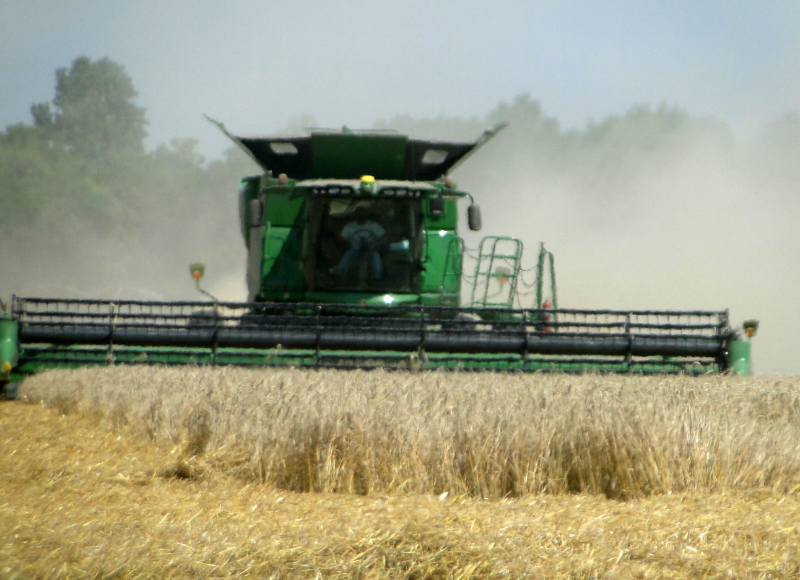Stiles: Survey takes on more significance with tight grain stocks
Even though the survey is routine for NASS, with the data setting its year-end estimates on wheat and oats and other grains as well as the Sept. 1 stocks of grain on hand, it may loom larger because of the shape of current grain markets.
Aug. 24, 2021
By Mary Hightower
U of A System Division of Agriculture
Fast facts:
- Surveys being sent to more than 1,400 Arkansas farmers
- Survey significant due to historically tight grain supplies
- Response deadline is Aug. 29
(448 words)
(Newsrooms - file image of wheat being harvested is here: https://flic.kr/p/o5a2Bx )
LITTLE ROCK — A routine survey being conducted by the National Agricultural Statistics
Service may carry additional significance because of the nation’s tight grain stocks,
said Scott Stiles, extension economist for the University of Arkansas System Division
of Agriculture.
The NASS, part of the U.S. Department of Agriculture, will be sending questionnaires to more than 1,400 Arkansas farmers to get a big picture of this year’s production of small grains, including wheat and oats.

The survey is being conducted “to accurately measure 2021 acreage, yield and production for small grain crops,” said Eugene Young, director of the Delta regional office for NASS. The data will be available on Quick Stats in the NASS site in December. Arkansas growers will also be asked about corn, soybeans and all wheat and oats stored on the farm.
The deadline to respond by mail or online is Aug. 29, and growers may submit their information online at https://agcounts.usda.gov. NASS said all the responses are confidential and all the data is aggregated so no individual operation or producer can be identified.
Tightest supplies since 2012
While the survey is routine for NASS, with the data setting its year-end estimates on wheat and oats and other grains as well as the Sept. 1 stocks of grain on hand, it may loom larger because of the shape of current grain markets.
"Adding importance to this survey is the fundamental character of the grain markets today,” said Scott Stiles, extension economist with the University of Arkansas System Division of Agriculture. “U.S. corn ending stocks are the tightest since 2012. Wheat and soybean stocks are the tightest since 2013. Oats ending stocks are at all-time lows.
“In other words, every bushel counts,” he said.
In addition to acreage reports and monthly crop production forecasts, USDA issues grain stocks reports in January, March, June and September.
“These reports complete the supply picture by showing stocks on hand from previous crops,” Stiles said. “In the case of corn and other feed grains, changes in stocks from one quarter to the next provide an indication of how much grain is being fed domestically.
“For corn, feed use is the single largest part of total demand,” he said. “For wheat, the USDA projects 160 million bushels will be used for feed in the 2021-22 marketing year.”
Stiles said the agriculture industry relies on these reports, which provide one piece of market information critical to price discovery.
“This information is only as good as what’s provided by growers and other industry members,” he said. In a time of tight supplies and added market volatility, accurate information is essential to help all market participants manage price risk—whether that’s producers or end users.”
To learn about extension programs in Arkansas, contact your local Cooperative Extension Service agent or visit www.uaex.uada.edu. Follow us on Twitter and Instagram at @AR_Extension. To learn more about Division of Agriculture research, visit the Arkansas Agricultural Experiment Station website: aaes.uada.edu. Follow on Twitter at @ArkAgResearch. To learn more about the Division of Agriculture, visit https://uada.edu/. Follow us on Twitter at @AgInArk.
About the Division of Agriculture
The University of Arkansas System Division of Agriculture’s mission is to strengthen agriculture, communities, and families by connecting trusted research to the adoption of best practices. Through the Agricultural Experiment Station and the Cooperative Extension Service, the Division of Agriculture conducts research and extension work within the nation’s historic land grant education system.
The Division of Agriculture is one of 20 entities within the University of Arkansas System. It has offices in all 75 counties in Arkansas and faculty on five system campuses.
Pursuant to 7 CFR § 15.3, the University of Arkansas System Division of Agriculture offers all its Extension and Research programs and services (including employment) without regard to race, color, sex, national origin, religion, age, disability, marital or veteran status, genetic information, sexual preference, pregnancy or any other legally protected status, and is an equal opportunity institution.
# # #
Contact:
Mary Hightower
mhigthower@uada.edu